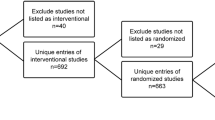Abstract
This paper describes the random allocation system used to perform precise and rapid treatment assignments in multi-institutional clinical trials. This system is based on sophisticated randomization procedures, according to Pocock and Simon's minimization method and Zelen's method for institution balancing. The major advantage of randomized treatment assignments with this system is to balance treatment numbers for each level of various prognostic factors over the entire trial and at the same time balance the allocation of treatments within an institution. Therefore, the randomized treatment assignments by this system can prevent degrading of the statistical power of a particular treatment factor. This system is designed to run on a small-sized notebook computer and therefore can be set up beside a telephone for registration, without occupying a large space. At present, this system is conveniently being used in two clinical trials.
Similar content being viewed by others
References
Matts, J.P., and Lachin, J.M., Properties of permuted-block randomization in clinical trials.Control. Clin. Trials 9:327–344, 1988.
Hallstrom, A., and Davis, K., Imbalance in treatment assignments in stratified blocked randomization.Control. Clin. Trials 9:375–382, 1988.
Kalish, L.A., and Begg, C.B., Treatment allocation methods in clinical trials: A review.Stat. Med. 4:129–144, 1985.
Pocock, S.J., Clinical trials, A practical approach. Wiley, Chichester, 66–89, 1983.
Zelen, M., The randomization and stratification of patients to clinical trials.J. Chron. Dis. 27:365–375, 1974.
Pocock, S.J., Allocation of patients to treatment in clinical trials.Biometrics 35:183–197, 1979.
Staquet, M., and Dalesio, O., Designs for phase III trials. InCancer Clinical Trials Buyse, M.E.,et al. (eds.), Oxford University Press, Oxford, pp. 261–275, 1988.
Akazawa, K., Nakamura, T., Moriguchi, S., Shimada, M., and Nose, Y., Simulation program for estimating statistical power of Cox's proportional hazards model assuming no specific distribution for the survival time.Comput. Methods Progr. Biomed. 35:203–212, 1991.
Johnson, M.E., Tolley, H.D., Bryson, M.C., and Goldman, A.S., Covariate analysis of survival data: A small-sample study of Cox's model.Biometrics 38:685–698, 1982.
Lange, N., and MacIntyre, J., A computerized patient registration and treatment randomization system for multi-institutional clinical trials.Control. Clin. Trials 6:38–50, 1985.
Krischer, J.P., Hurley, C., Pillalamarri, M., Pant, S., Bleichfeld, C., Opel, M., and Shuster, J.J., An automated patient registration and treatment randomization system for multicenter clinical trials.Control. Clin. Trials 12:367–377, 1991.
Author information
Authors and Affiliations
Rights and permissions
About this article
Cite this article
Akazawa, K., Odaka, T., Sakamoto, M. et al. A random allocation system with the minimization method for multi-institutional clinical trials. J Med Syst 15, 311–319 (1991). https://doi.org/10.1007/BF00999168
Issue Date:
DOI: https://doi.org/10.1007/BF00999168




